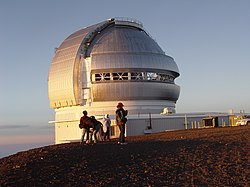
Brown dwarfs are substellar objects that have more mass than the biggest gas giant planets, but less than the least massive main-sequence stars. Their mass is approximately 13 to 80 times that of Jupiter (MJ) -- not big enough to sustain nuclear fusion of ordinary hydrogen (1H) into helium in their cores, but massive enough to emit some light and heat from the fusion of deuterium (2H). The most massive ones can fuse lithium (7Li).

A rogue planet is an interstellar object of planetary mass which is not gravitationally bound to any star or brown dwarf. Rogue planets may originate from planetary systems in which they are formed and later ejected, or they can also form on their own, outside a planetary system. The Milky Way alone may have billions to trillions of rogue planets, a range the upcoming Nancy Grace Roman Space Telescope will likely be able to narrow.
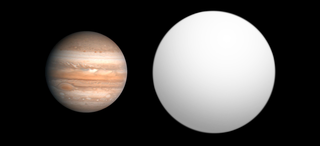
2M1207b is a planetary-mass object orbiting the brown dwarf 2M1207, in the constellation Centaurus, approximately 170 light-years from Earth. It is one of the first candidate exoplanets to be directly observed. It was discovered in April 2004 by the Very Large Telescope (VLT) at the Paranal Observatory in Chile by a team from the European Southern Observatory led by Gaël Chauvin. It is believed to be from 5 to 6 times the mass of Jupiter and may orbit 2M1207 at a distance roughly as far from the brown dwarf as Pluto is from the Sun.

Theta Cygni is a star in the northern constellation of Cygnus. It has an apparent visual magnitude of 4.5, so it can be seen from the northern hemisphere with the naked eye in sufficiently dark skies. Based upon parallax measurements, it is at a distance of about 59.8 light-years from the Earth. It is suspected of hosting an extrasolar planet.

Oph 162225-240515, often abbreviated Oph 1622, and also known as Oph 11, is a pair of brown dwarfs that have been reported as orbiting each other. The bodies are located in the constellation Scorpius and are about 400 light years away. Mass estimates of the two objects are uncertain, but they are probably each higher than the brown-dwarf/planet dividing line of 13 Jupiter masses. Oph1622B is located 1.94 arcseconds from Oph1622A, at a position angle of 182°.
HD 159868 is a star in the southern constellation of Scorpius, positioned about 0.3° to the ESE of the bright star Theta Scorpii. With an apparent visual magnitude of +7.24, it is too faint to be visible to the naked eye but can be viewed with a small telescope. The star lies at a distance of 183 light years from the Sun based on parallax, but is drifting closer with a radial velocity of −24 km/s.
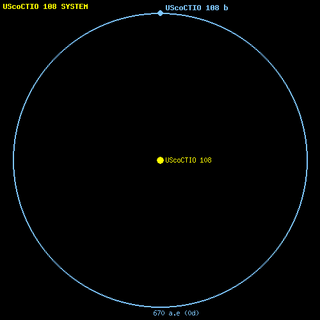
UScoCTIO 108 is a binary system, approximately 470 light-years away in the Upper Scorpius (USco) OB association. The primary, UScoCTIO 108A, with mass around 0.06 solar masses, is a brown dwarf or low-mass red dwarf. The secondary, UScoCTIO 108B, with a mass around the deuterium burning limit of 13 Jupiter masses, would be classified as either a brown dwarf or an extrasolar planet.
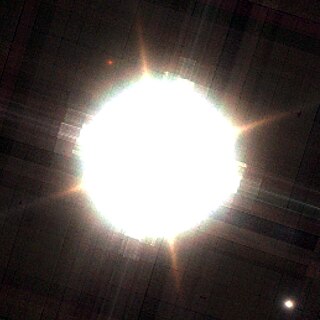
1RXS J160929.1−210524 is a pre-main-sequence star approximately 456 light-years away in the constellation of Scorpius.
HD 16760 is a binary star system approximately 227 light-years away in the constellation Perseus. The primary star HD 16760 is a G-type main sequence star similar to the Sun. The secondary, HIP 12635 is 1.521 magnitudes fainter and located at a separation of 14.6 arcseconds from the primary, corresponding to a physical separation of at least 660 AU. Announced in July 2009, HD 16760 has been confirmed to have a red dwarf orbiting it, formerly thought to be a brown dwarf or exoplanet.

WISE 1828+2650 is a possibly binary brown dwarf or rogue planet of spectral class >Y2, located in the constellation Lyra at approximately 32.5 light-years from Earth. It is the "archetypal member" of the Y spectral class.

Strategic Explorations of Exoplanets and Disks with Subaru (SEEDS) is a multi-year survey that used the Subaru Telescope on Mauna Kea, Hawaii in an effort to directly image extrasolar planets and protoplanetary/debris disks around hundreds of nearby stars. SEEDS is a Japanese-led international project. It consists of some 120 researchers from a number of institutions in Japan, the U.S. and the EU. The survey's headquarters is at the National Astronomical Observatory of Japan (NAOJ) and led by Principal Investigator Motohide Tamura. The goals of the survey are to address the following key issues in the study of extrasolar planets and disks: the detection and census of exoplanets in the regions around solar-mass and massive stars; the evolution of protoplanetary disks and debris disks; and the link between exoplanets and circumstellar disks.

Luhman 16 is a binary brown-dwarf system in the southern constellation Vela at a distance of approximately 6.5 light-years from the Sun. These are the closest-known brown dwarfs and the closest system found since the measurement of the proper motion of Barnard's Star in 1916, and the third-closest-known system to the Sun. The primary is of spectral type L7.5 and the secondary of type T0.5 ± 1. The masses of Luhman 16 A and B are 33.5 and 28.6 Jupiter masses, respectively, and their ages are estimated to be 600–800 million years. Luhman 16 A and B orbit each other at a distance of about 3.5 astronomical units with an orbital period of approximately 27 years.
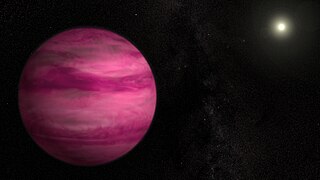
Gliese 504 b is a Jovian planet or brown dwarf located in the system of the solar analog 59 Virginis, discovered by direct imaging using HiCIAO instrument and AO188 adaptive optics system on the 8.2-meter Subaru Telescope of Mauna Kea Observatory, Hawaii by Kuzuhara et al. Visually, GJ 504 b would have a dull magenta color. It can be seen from Earth in the constellation Virgo.

HD 106906 b is a directly imaged planetary-mass companion and candidate exoplanet orbiting the star HD 106906, in the constellation Crux at about 336 ± 13 light-years (103 ± 4 pc) from Earth. It is estimated to be about eleven times the mass of Jupiter and is located about 738 AU away from its host star. HD 106906 b is an oddity; while its mass estimate is nominally consistent with identifying it as an exoplanet, it appears at a much wider separation from its parent star than thought possible for in-situ formation from a protoplanetary disk.

WISE 0855−0714 is a sub-brown dwarf 2.28±0.01 parsecs from Earth, therefore the fourth-closest star or (sub-) brown dwarf system to the Sun, the discovery of which was announced in April 2014 by Kevin Luhman using data from the Wide-field Infrared Survey Explorer (WISE). As of 2014, WISE 0855−0714 has the third-highest proper motion after Barnard's Star and Kapteyn's Star and the fourth-largest parallax of any known star or brown dwarf. It is also the coldest object of its type found in interstellar space, having a temperature in the range 225 to 260 K.

HD 115600 is a star in the constellation Centaurus and a member of the Scorpius–Centaurus association, the nearest OB association to the Sun and the host star of a bright Kuiper belt-like debris ring.

K2-33 is an extremely young pre-main-sequence star located about 456 light-years (140 pc) away from the Earth in the constellation of Scorpius. It is known to host one planet, a super-Neptune, named K2-33b. It is also notable for its young age.
HD 142250 is a star in the constellation Scorpius. It has a visual apparent magnitude of 6.1, being visible to the naked eye only in excellent seeing conditions. From parallax measurements, it is located 486 light-years (149 parsecs) away from Earth. This distance, together with the star's proper motion, indicate that HIP 77900 is a member of the Upper Scorpius subgroup of the Scorpius–Centaurus association, the nearest OB association to the Sun. This subgroup is the youngest of the three of the association, with an estimated age of 11 million years.
HIP 79098 is a binary star in the constellation Scorpius. It has a visual apparent magnitude of +5.88, being visible to the naked eye under very dark skies. From parallax measurements by the Gaia spacecraft, it is located approximately 500 light-years from Earth.
